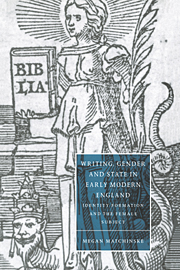Book contents
- Frontmatter
- Contents
- Acknowledgments
- Introduction
- 1 Resistance, Reformation, and the remaining narratives
- 2 Framing recusant identity in Counter-Reformation England
- 3 Legislating morality in the marriage market
- 4 Gender formation in English apocalyptic writing
- 5 Connections, qualifications, and agendas
- Notes
- Bibliography
- Index
- Cambridge Studies in Renaissance Literature and Culture
4 - Gender formation in English apocalyptic writing
Published online by Cambridge University Press: 23 October 2009
- Frontmatter
- Contents
- Acknowledgments
- Introduction
- 1 Resistance, Reformation, and the remaining narratives
- 2 Framing recusant identity in Counter-Reformation England
- 3 Legislating morality in the marriage market
- 4 Gender formation in English apocalyptic writing
- 5 Connections, qualifications, and agendas
- Notes
- Bibliography
- Index
- Cambridge Studies in Renaissance Literature and Culture
Summary
Thus Reader in a word to thee, what the unsealed words of this Prophesie imports; We even in the same Estate with them … Here impeached of the sin against the Holy Ghost, guilty of the blood of these his sacred Ambassadors … wonders of the highest kinde at their word, waters turn'd into blood, War forshewed, Heaven shut, and the like, smite the Earth with plagues as often as they speak the word, yet these rash wretches … clad in sack cloth … triumphing over their corps slain by the Beast coming out of the smoking pit or Abyss … making War with them, with his furious Train, armed at all points this British Beast.
In the 1640s the prophet Lady Eleanor Davies warned her readers of imminent doom, of the coming of the apocalypse or endtimes. Like many writers during this period, Davies constructed a millennial accounting of the British nation. She posited individual sin within an already established Calvinist frame, anticipated an immediate and specific end to the world as we know it, and demanded death for her adversaries. As individual sinners, Davies's readers were “impeached of the sin against the Holy Ghost” and “guilty [if only by association] of the blood of … his sacred Ambassadors.”
- Type
- Chapter
- Information
- Writing, Gender and State in Early Modern EnglandIdentity Formation and the Female Subject, pp. 127 - 155Publisher: Cambridge University PressPrint publication year: 1998



